TOYOTA VERSO 2011 Owners Manual
Manufacturer: TOYOTA, Model Year: 2011, Model line: VERSO, Model: TOYOTA VERSO 2011Pages: 588, PDF Size: 31.32 MB
Page 531 of 588
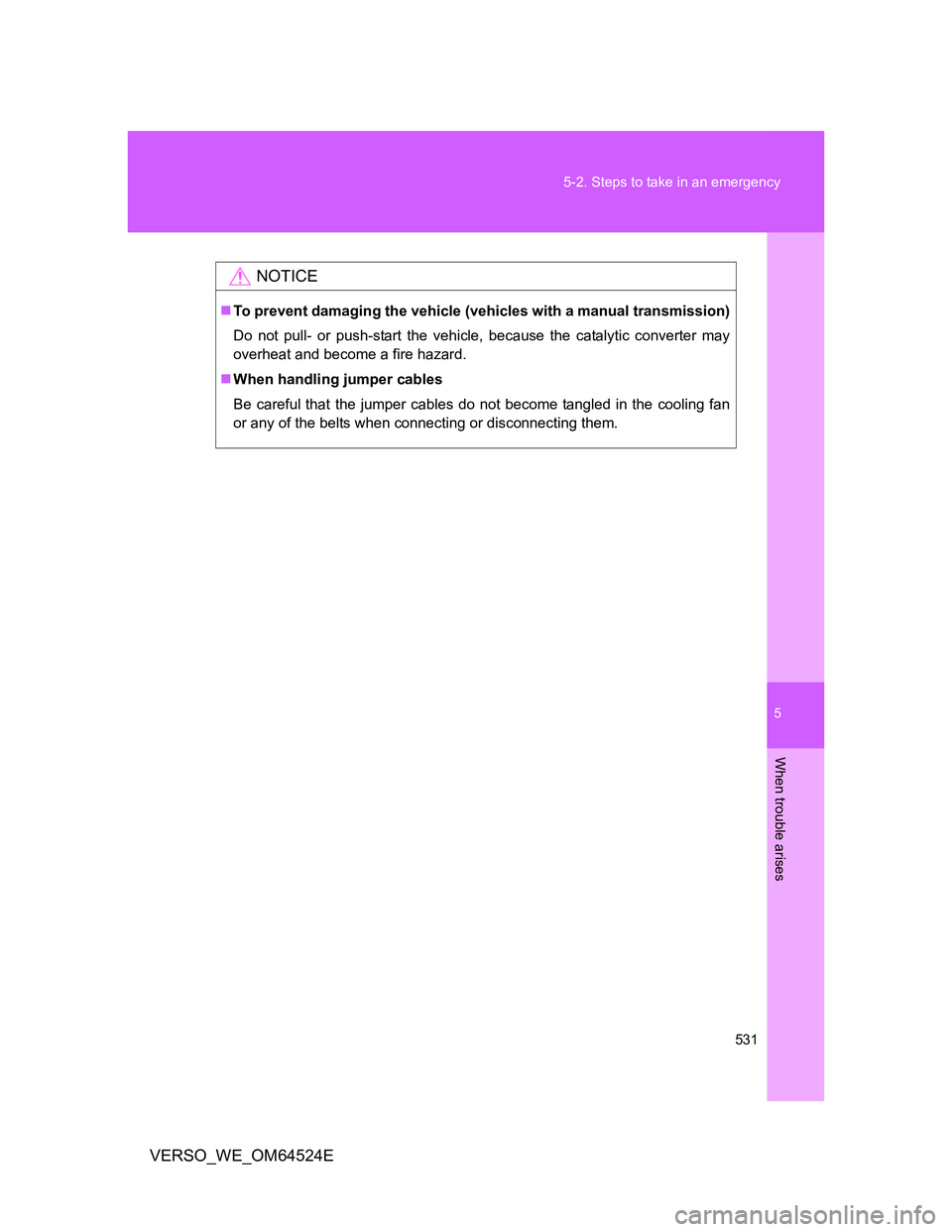
5
531 5-2. Steps to take in an emergency
When trouble arises
VERSO_WE_OM64524E
NOTICE
To prevent damaging the vehicle (vehicles with a manual transmission)
Do not pull- or push-start the vehicle, because the catalytic converter may
overheat and become a fire hazard.
When handling jumper cables
Be careful that the jumper cables do not become tangled in the cooling fan
or any of the belts when connecting or disconnecting them.
Page 532 of 588
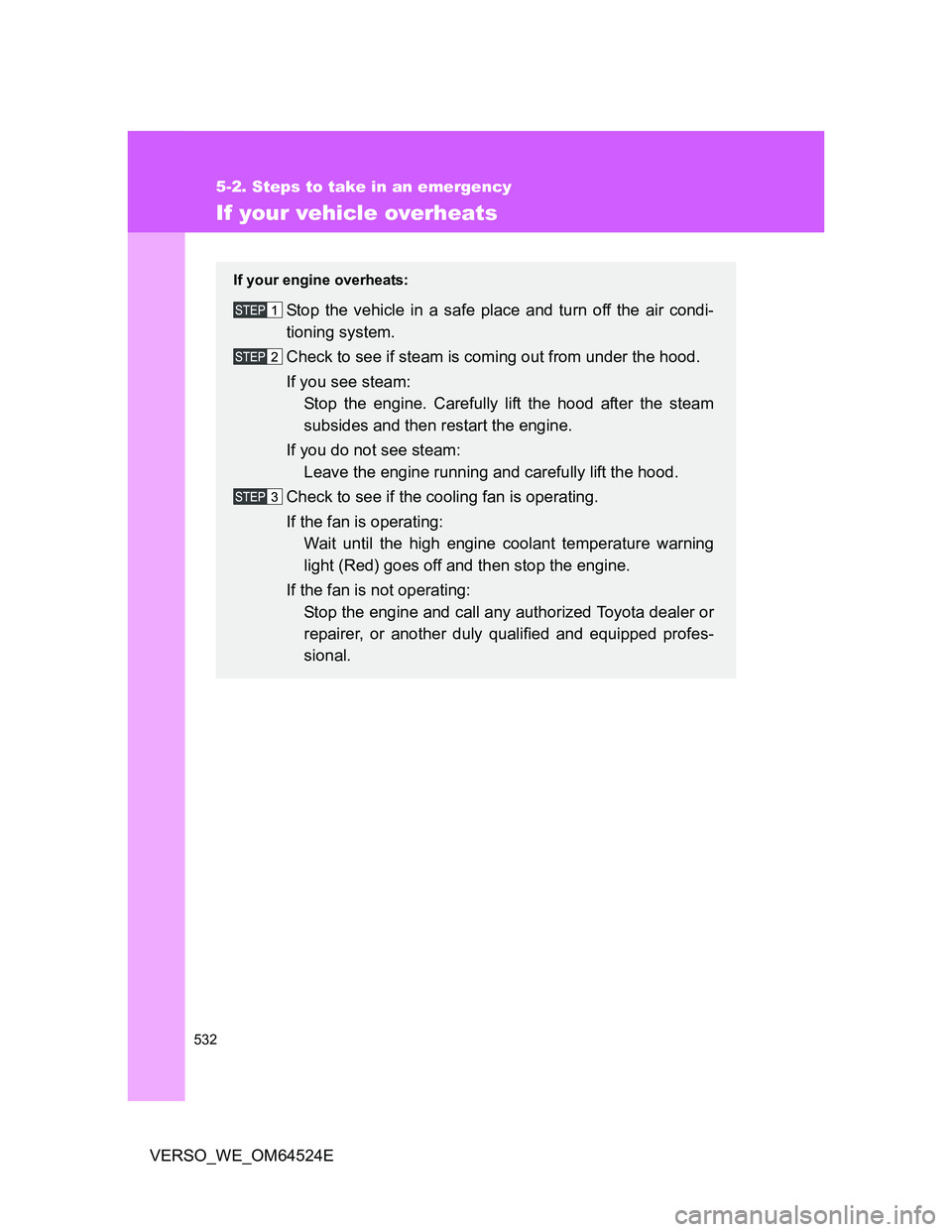
532
5-2. Steps to take in an emergency
VERSO_WE_OM64524E
If your vehicle overheats
If your engine overheats:
Stop the vehicle in a safe place and turn off the air condi-
tioning system.
Check to see if steam is coming out from under the hood.
If you see steam:
Stop the engine. Carefully lift the hood after the steam
subsides and then restart the engine.
If you do not see steam:
Leave the engine running and carefully lift the hood.
Check to see if the cooling fan is operating.
If the fan is operating:
Wait until the high engine coolant temperature warning
light (Red) goes off and then stop the engine.
If the fan is not operating:
Stop the engine and call any authorized Toyota dealer or
repairer, or another duly qualified and equipped profes-
sional.
Page 533 of 588
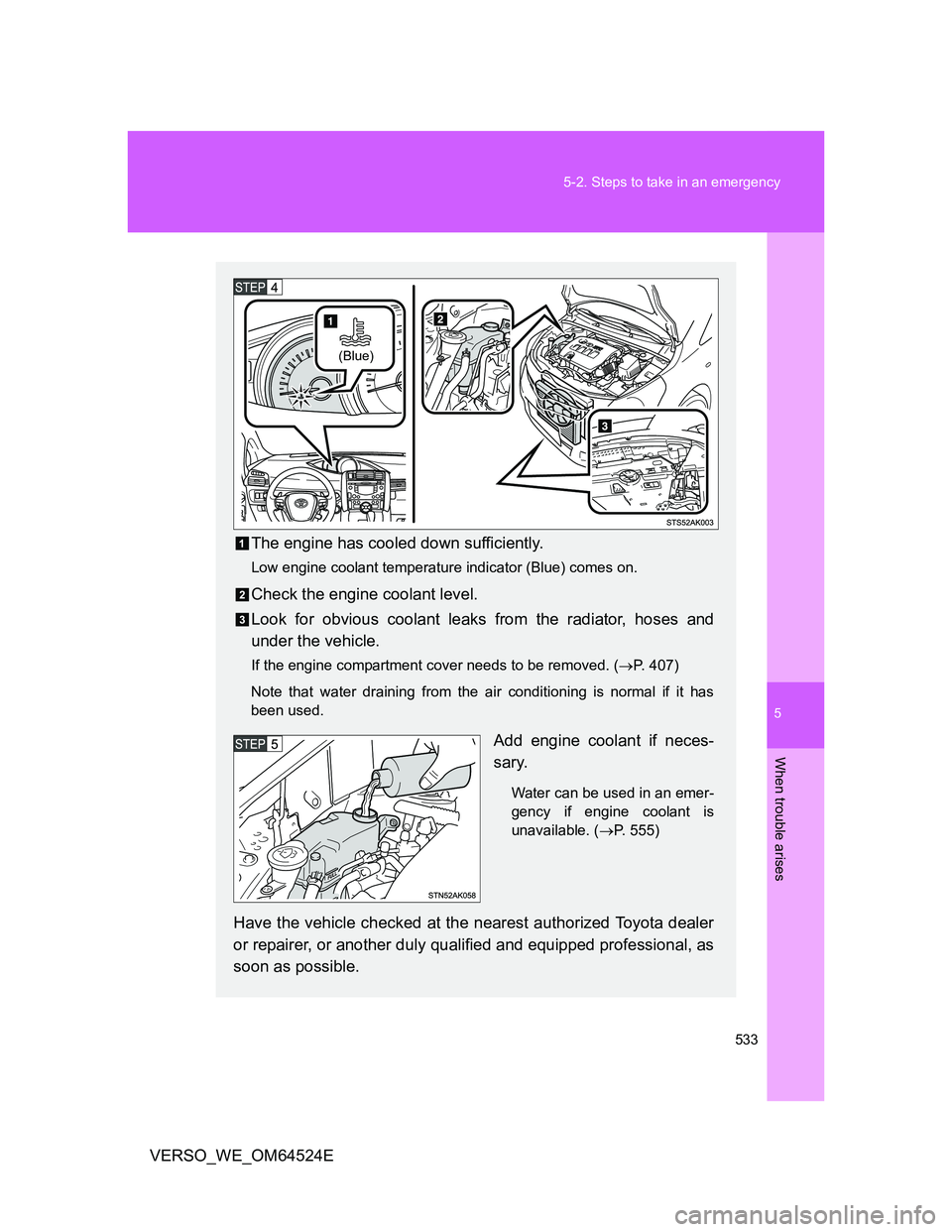
5
533 5-2. Steps to take in an emergency
When trouble arises
VERSO_WE_OM64524E
The engine has cooled down sufficiently.
Low engine coolant temperature indicator (Blue) comes on.
Check the engine coolant level.
Look for obvious coolant leaks from the radiator, hoses and
under the vehicle.
If the engine compartment cover needs to be removed. (P. 407)
Note that water draining from the air conditioning is normal if it has
been used.
Add engine coolant if neces-
sary.
Water can be used in an emer-
gency if engine coolant is
unavailable. (P. 555)
Have the vehicle checked at the nearest authorized Toyota dealer
or repairer, or another duly qualified and equipped professional, as
soon as possible.
(Blue)
Page 534 of 588
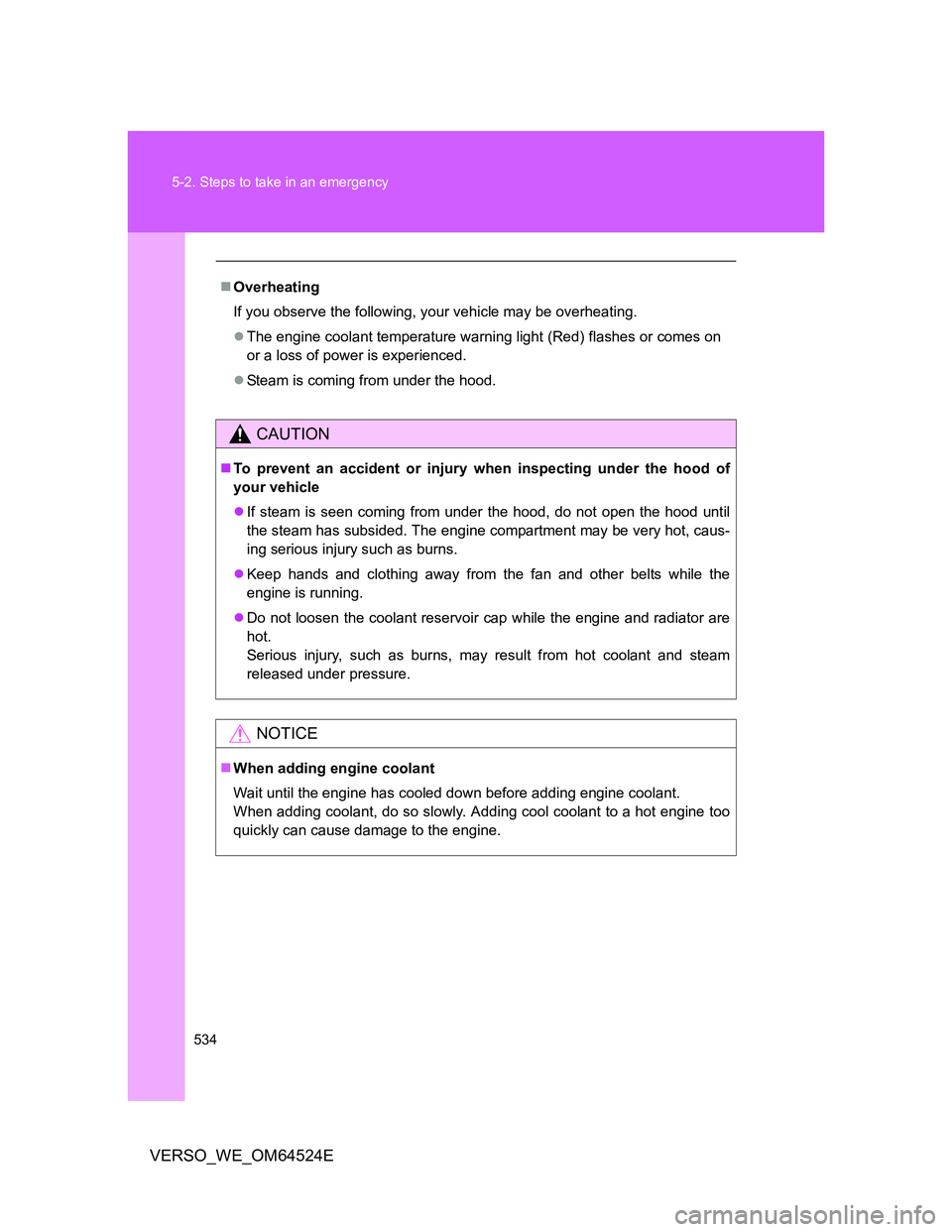
534 5-2. Steps to take in an emergency
VERSO_WE_OM64524E
Overheating
If you observe the following, your vehicle may be overheating.
The engine coolant temperature warning light (Red) flashes or comes on
or a loss of power is experienced.
Steam is coming from under the hood.
CAUTION
To prevent an accident or injury when inspecting under the hood of
your vehicle
If steam is seen coming from under the hood, do not open the hood until
the steam has subsided. The engine compartment may be very hot, caus-
ing serious injury such as burns.
Keep hands and clothing away from the fan and other belts while the
engine is running.
Do not loosen the coolant reservoir cap while the engine and radiator are
hot.
Serious injury, such as burns, may result from hot coolant and steam
released under pressure.
NOTICE
When adding engine coolant
Wait until the engine has cooled down before adding engine coolant.
When adding coolant, do so slowly. Adding cool coolant to a hot engine too
quickly can cause damage to the engine.
Page 535 of 588
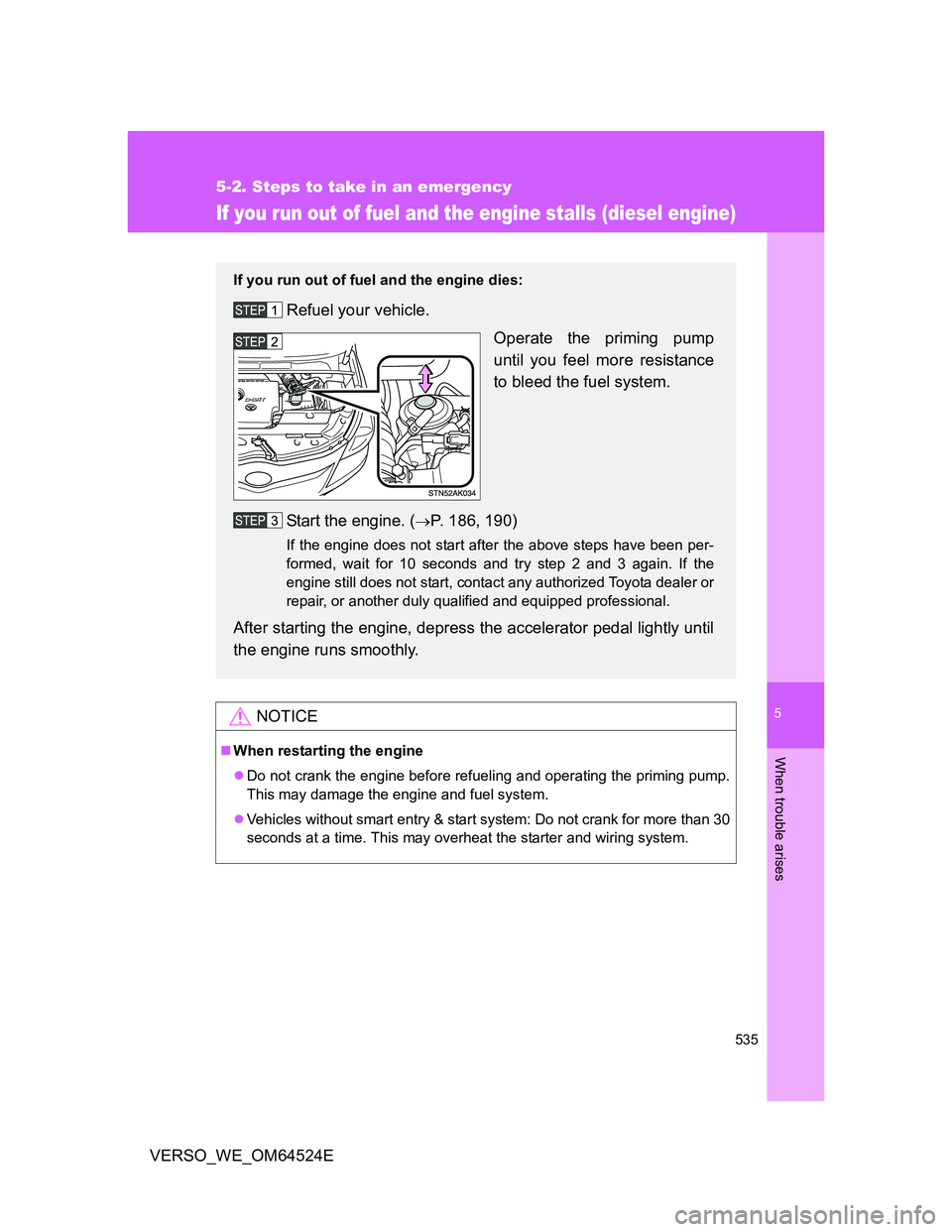
5
535
5-2. Steps to take in an emergency
When trouble arises
VERSO_WE_OM64524E
If you run out of fuel and the engine stalls (diesel engine)
NOTICE
When restarting the engine
Do not crank the engine before refueling and operating the priming pump.
This may damage the engine and fuel system.
Vehicles without smart entry & start system: Do not crank for more than 30
seconds at a time. This may overheat the starter and wiring system.
If you run out of fuel and the engine dies:
Refuel your vehicle.
Operate the priming pump
until you feel more resistance
to bleed the fuel system.
Start the engine. (
P. 186, 190)
If the engine does not start after the above steps have been per-
formed, wait for 10 seconds and try step 2 and 3 again. If the
engine still does not start, contact any authorized Toyota dealer or
repair, or another duly qualified and equipped professional.
After starting the engine, depress the accelerator pedal lightly until
the engine runs smoothly.
Page 536 of 588
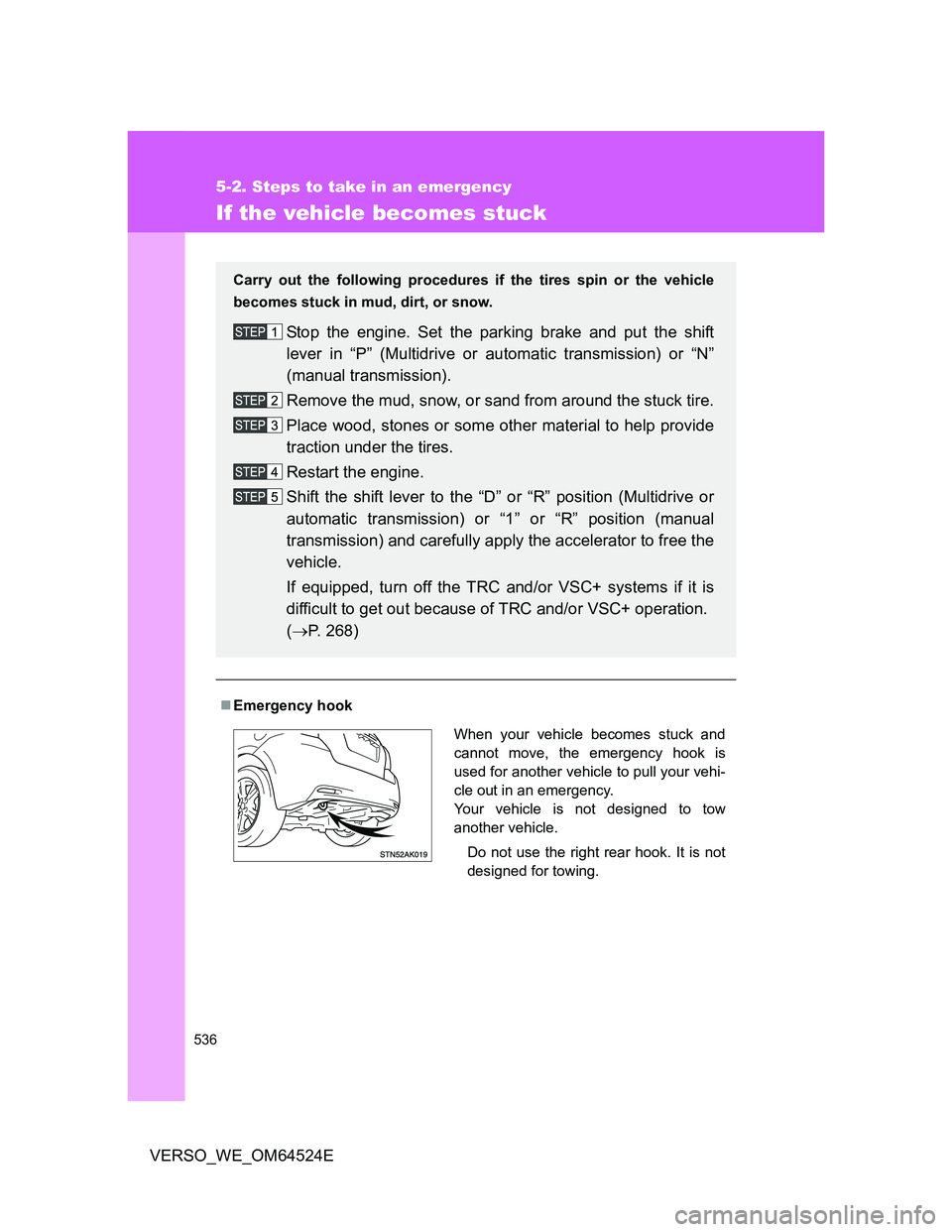
536
5-2. Steps to take in an emergency
VERSO_WE_OM64524E
If the vehicle becomes stuck
Emergency hook
Carry out the following procedures if the tires spin or the vehicle
becomes stuck in mud, dirt, or snow.
Stop the engine. Set the parking brake and put the shift
lever in “P” (Multidrive or automatic transmission) or “N”
(manual transmission).
Remove the mud, snow, or sand from around the stuck tire.
Place wood, stones or some other material to help provide
traction under the tires.
Restart the engine.
Shift the shift lever to the “D” or “R” position (Multidrive or
automatic transmission) or “1” or “R” position (manual
transmission) and carefully apply the accelerator to free the
vehicle.
If equipped, turn off the TRC and/or VSC+ systems if it is
difficult to get out because of TRC and/or VSC+ operation.
(P. 268)
When your vehicle becomes stuck and
cannot move, the emergency hook is
used for another vehicle to pull your vehi-
cle out in an emergency.
Your vehicle is not designed to tow
another vehicle.
Do not use the right rear hook. It is not
designed for towing.
Page 537 of 588
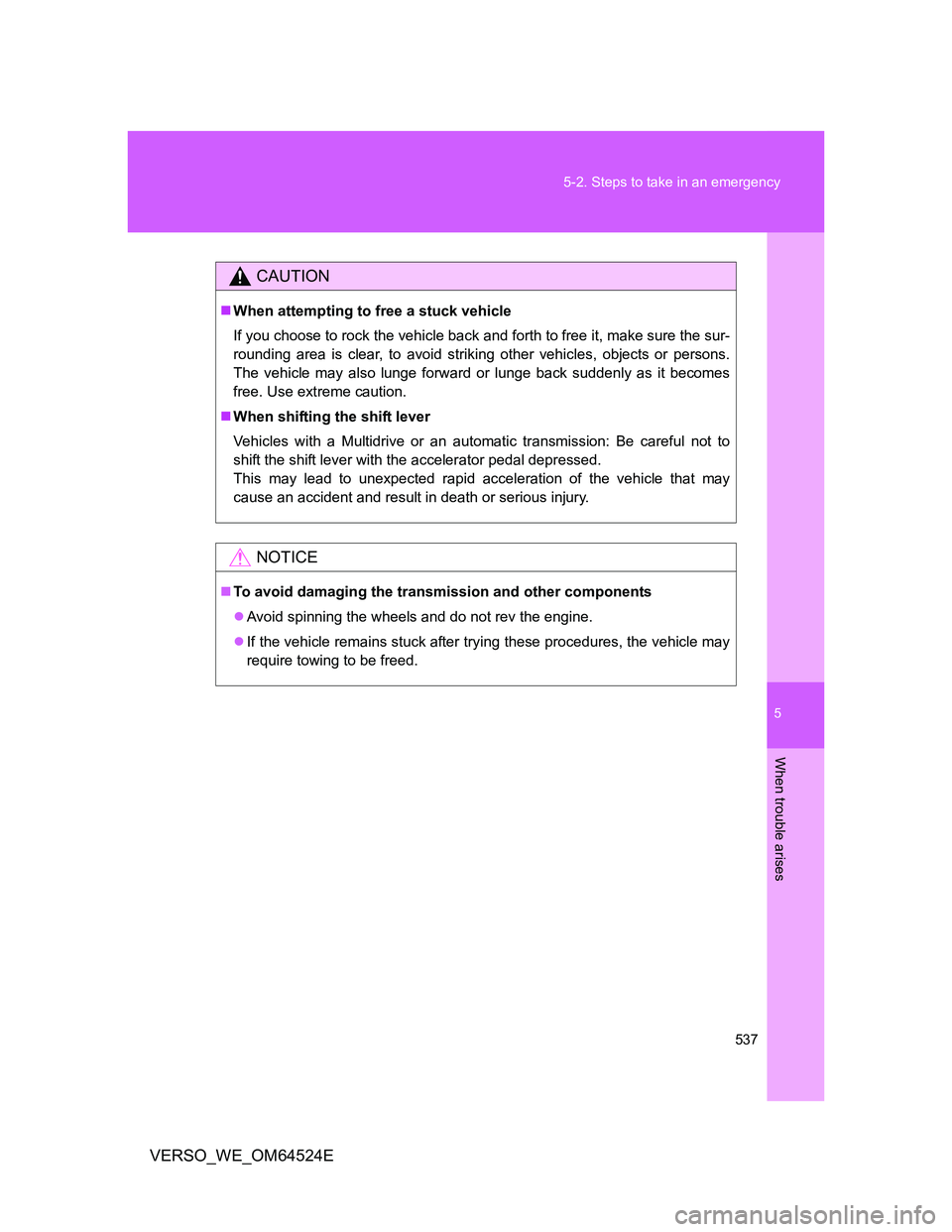
5
537 5-2. Steps to take in an emergency
When trouble arises
VERSO_WE_OM64524E
CAUTION
When attempting to free a stuck vehicle
If you choose to rock the vehicle back and forth to free it, make sure the sur-
rounding area is clear, to avoid striking other vehicles, objects or persons.
The vehicle may also lunge forward or lunge back suddenly as it becomes
free. Use extreme caution.
When shifting the shift lever
Vehicles with a Multidrive or an automatic transmission: Be careful not to
shift the shift lever with the accelerator pedal depressed.
This may lead to unexpected rapid acceleration of the vehicle that may
cause an accident and result in death or serious injury.
NOTICE
To avoid damaging the transmission and other components
Avoid spinning the wheels and do not rev the engine.
If the vehicle remains stuck after trying these procedures, the vehicle may
require towing to be freed.
Page 538 of 588
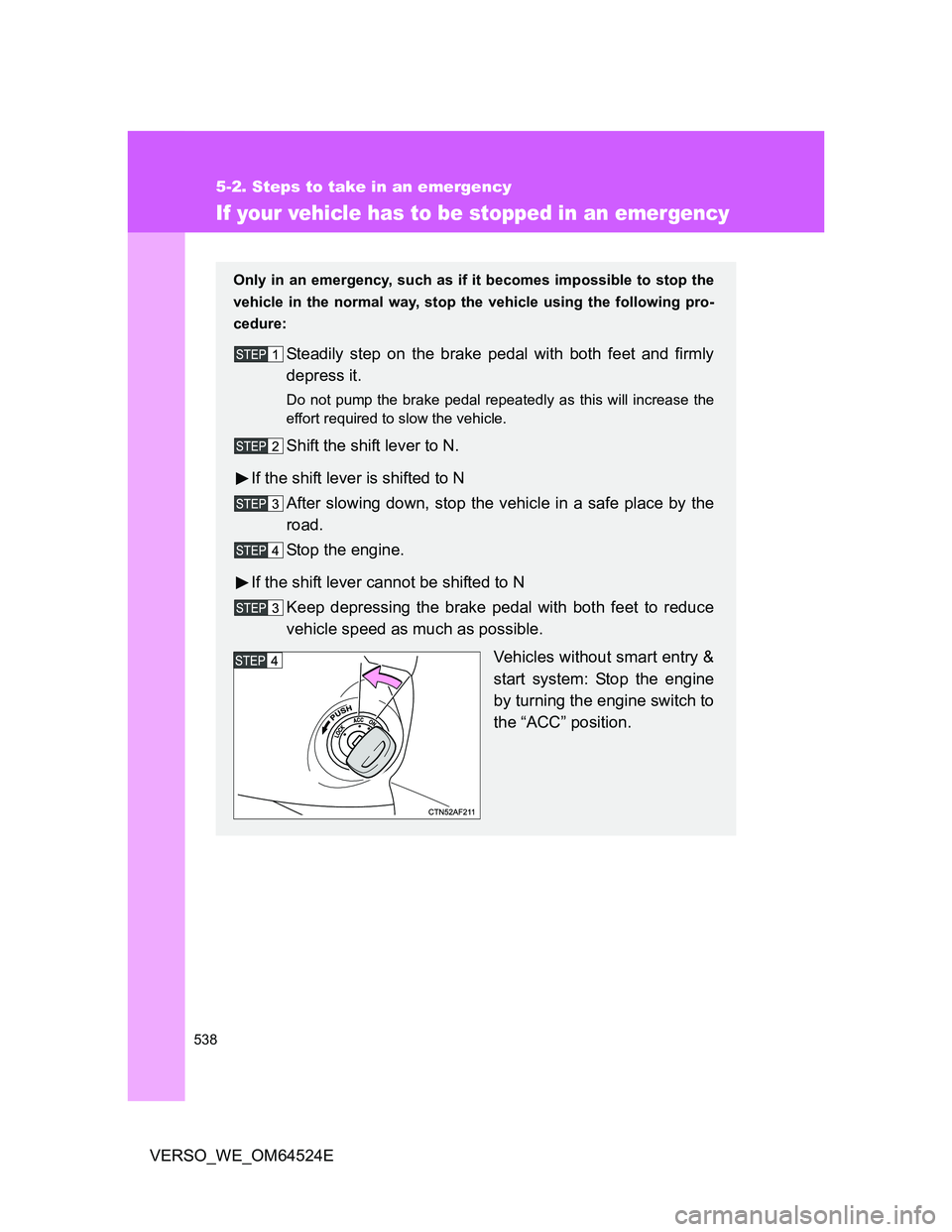
538
5-2. Steps to take in an emergency
VERSO_WE_OM64524E
If your vehicle has to be stopped in an emergency
Only in an emergency, such as if it becomes impossible to stop the
vehicle in the normal way, stop the vehicle using the following pro-
cedure:
Steadily step on the brake pedal with both feet and firmly
depress it.
Do not pump the brake pedal repeatedly as this will increase the
effort required to slow the vehicle.
Shift the shift lever to N.
If the shift lever is shifted to N
After slowing down, stop the vehicle in a safe place by the
road.
Stop the engine.
If the shift lever cannot be shifted to N
Keep depressing the brake pedal with both feet to reduce
vehicle speed as much as possible.
Vehicles without smart entry &
start system: Stop the engine
by turning the engine switch to
the “ACC” position.
Page 539 of 588
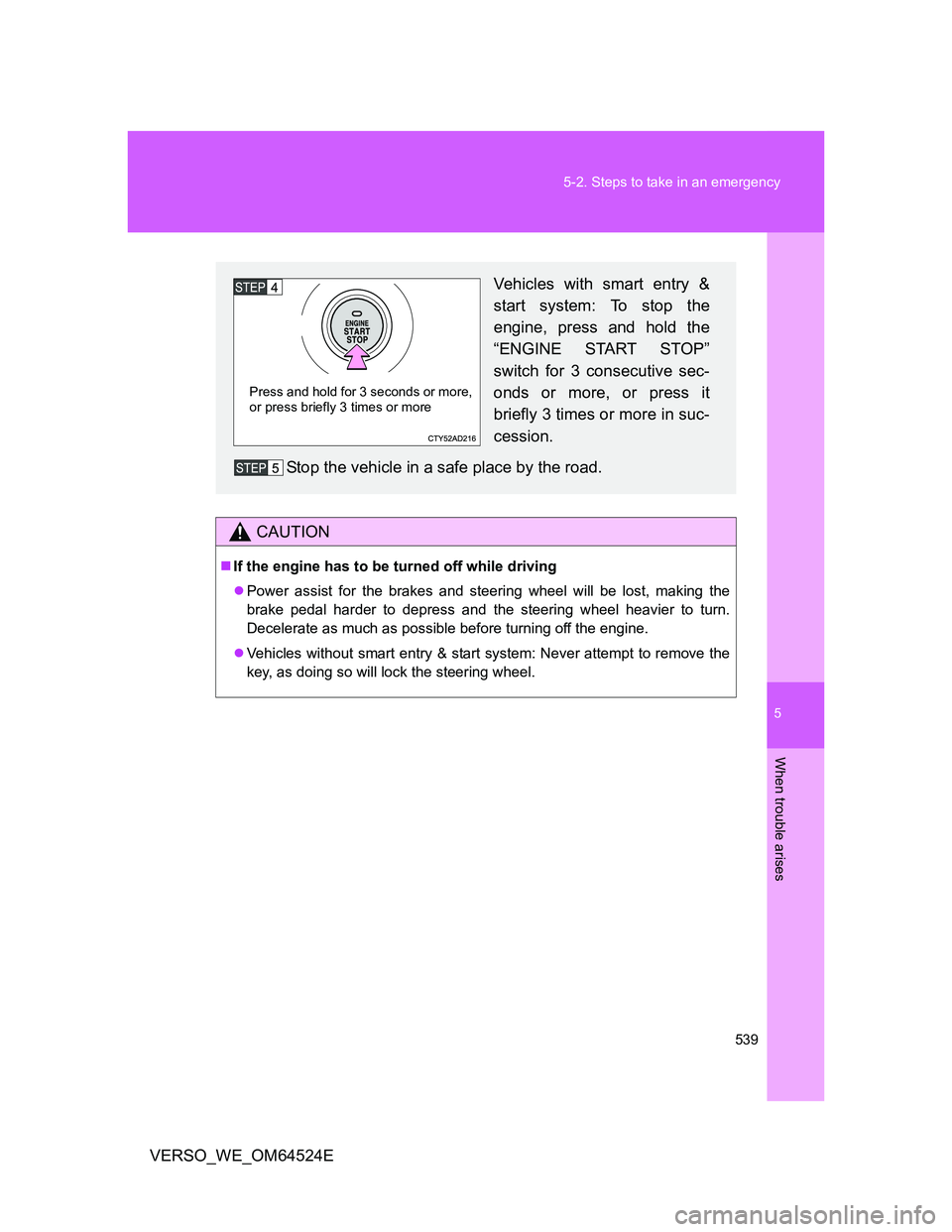
5
539 5-2. Steps to take in an emergency
When trouble arises
VERSO_WE_OM64524E
CAUTION
If the engine has to be turned off while driving
Power assist for the brakes and steering wheel will be lost, making the
brake pedal harder to depress and the steering wheel heavier to turn.
Decelerate as much as possible before turning off the engine.
Vehicles without smart entry & start system: Never attempt to remove the
key, as doing so will lock the steering wheel.
Vehicles with smart entry &
start system: To stop the
engine, press and hold the
“ENGINE START STOP”
switch for 3 consecutive sec-
onds or more, or press it
briefly 3 times or more in suc-
cession.
Stop the vehicle in a safe place by the road.
Press and hold for 3 seconds or more,
or press briefly 3 times or more
Page 540 of 588

540 5-2. Steps to take in an emergency
VERSO_WE_OM64524E